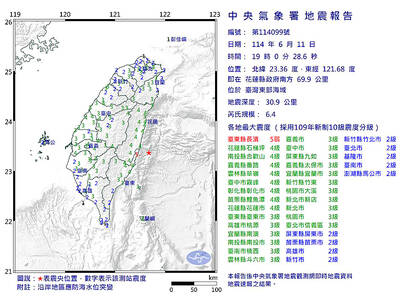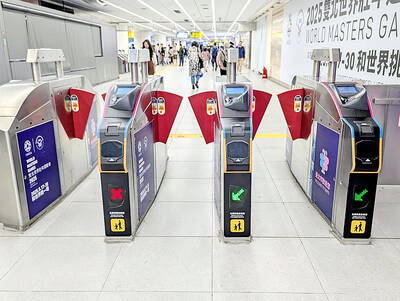Some of the most attractive and hardy common ornamental plants are packed with poison, herbalists told teachers at a special session organized by the Department of Health yesterday.
Both medicinal and harmful plants occur in abundance on school grounds and in parks, gardens and other public areas, said Kuo Chao-lin (郭昭麟), associate professor at Taichung's China Medical University.
Kuo was commissioned by the department's committee on Chinese medicine and pharmacy to produce two public education posters, one showing common poisonous plants and the other showing how to identify dried Chinese medicine.
He will also be holding lectures for primary and secondary school teachers to educate them on how to protect children from poisonous plants.
"Children are naturally curious about plants, especially interesting plants like the sea mango, or Cerbera manghas," Kuo said. "They might touch it or even try to eat the fruit."
Although the sea mango superficially resembles the common mango, it is packed with poisonous alkaloids, Kuo said.
Sea mangos, daturas and oleanders and other common schoolyard plants are all potentially deadly, Kuo said.
"Schools choose them because they are attractive and easy to care for," said Kuo.
Apart from poisonous plants, medicinal plants also abound in green spaces all around us, Kuo said. He advised non-professionals against self-medicating.
In one case of mistaken identity, an amateur herbalist ingested enough digitalis by accident to require hospitalization, Kuo said.
Cases of mild poisoning by the herb Typhonium divaricatum, a common plant easily identified by its heart-shaped leaves with a dart-like tip, have also been reported. Although the plant's tuber is considered a Chinese cure for certain lung ailments, both the tuber and the leaves contain large quantities of poisonous alkaloids.
"Somehow, it gained a totally specious reputation for curing cancer," Kuo said. "So people started eating its leaves."
Initial side-effects of ingesting Typhonium divaricatum leaves include a numb mouth and stinging sensation in the throat. More serious effects include breathing irregularities, Kuo said.

A magnitude 6.4 earthquake struck off the coast of Hualien County in eastern Taiwan at 7pm yesterday, the Central Weather Administration (CWA) said. The epicenter of the temblor was at sea, about 69.9km south of Hualien County Hall, at a depth of 30.9km, it said. There were no immediate reports of damage resulting from the quake. The earthquake’s intensity, which gauges the actual effect of a temblor, was highest in Taitung County’s Changbin Township (長濱), where it measured 5 on Taiwan’s seven-tier intensity scale. The quake also measured an intensity of 4 in Hualien, Nantou, Chiayi, Yunlin, Changhua and Miaoli counties, as well as

Credit departments of farmers’ and fishers’ associations blocked a total of more than NT$180 million (US$6.01 million) from being lost to scams last year, National Police Agency (NPA) data showed. The Agricultural Finance Agency (AFA) said last week that staff of farmers’ and fishers’ associations’ credit departments are required to implement fraud prevention measures when they serve clients at the counter. They would ask clients about personal financial management activities whenever they suspect there might be a fraud situation, and would immediately report the incident to local authorities, which would send police officers to the site to help, it said. NPA data showed

ENERGY RESILIENCE: Although Alaska is open for investments, Taiwan is sourcing its gas from the Middle East, and the sea routes carry risks, Ho Cheng-hui said US government officials’ high-profile reception of a Taiwanese representative at the Alaska Sustainable Energy Conference indicated the emergence of an Indo-Pacific energy resilience alliance, an academic said. Presidential Office Secretary-General Pan Men-an (潘孟安) attended the conference in Alaska on Thursday last week at the invitation of the US government. Pan visited oil and gas facilities with senior US officials, including US Secretary of the Interior Doug Burgum, US Secretary of Energy Chris Wright, Alaska Governor Mike Dunleavy and US Senator Daniel Sullivan. Pan attending the conference on behalf of President William Lai (賴清德) shows a significant elevation in diplomatic representation,

The Taipei MRT is to begin accepting mobile payment services in the fall, Taipei Rapid Transit Corp said on Saturday. When the company finishes the installation of new payment units at ticketing gates in October, MRT passengers can use credit cards, Apple Pay, Google Pay and Samsung Pay, the operator said. In addition, the MRT would also provide QR payment codes — which would be compatible with Line Pay, Jkopay, iPass Money, PXPay Plus, EasyWallet, iCash Pay, Taiwan Pay and Taishin Pay — to access the railway system. Currently, passengers can access the Taipei MRT by buying a single-journey token or using EasyCard,